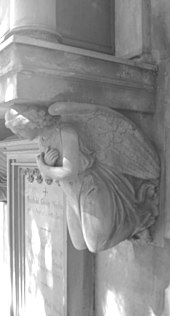Console (construction)
As a console or corbel (also Krage , rare bar , power , load-bearing , art or Notstein ; double. Corbeau or cul-de-lamp , engl. Corbel ) is in the construction industry refers to an outstanding out of the wall-supporting projection. Other components such as cornices , vault ribs , arches , figures , columns , pilasters , balconies or beams can be placed on it. Depending on the place of use, consoles can represent a pure design element, a pure load-bearing element or a mixture of both.
Consoles in architecture
Consoles are in the architecture often a design element in addition to the function as a supporting element. As a rule, they are made of natural stone or masonry , in timber framework one speaks of knaggen . In rather rare cases, they can also be made of wood or metal and, as a decorative work, also made of fired clay , plaster , stone cardboard , etc.
A tongue or anchor stone is a special form of the console in which the part of the console stone lying in the wall is dovetail-shaped. This is a particularly strong connection with the masonry that prevents the stone from slipping out.
Consoles are often decorated with ornaments or figures. In Romanesque architecture they were often given grimaces, obscenities, etc., which on the one hand can have a demon or general disaster-warding ( apotropaic ) meaning, but on the other hand can also be understood as drolleries or handcraft gimmicks. They have often been designed as volutes since the late renaissance .
Consoles in structural engineering
Consoles are used primarily in high-rise buildings , factories and industrial halls, as well as engineering structures, in order to introduce loads into a column or wall. The use there mostly has functional reasons, the design aspect is in the background. The material is usually chosen according to the surrounding supporting structure. Are common steel and reinforced concrete . Typical applications for consoles are the support of crane runways for bridge cranes in halls and the connection of precast concrete parts .
Consoles in reinforced concrete construction
In precast construction , beams are usually designed as single-span girders. The beam loads are introduced into the continuous columns via brackets. In order not to restrict the height of the room under the console, the beams in the support area are notched according to the console size ("offset support"). The beam theory is no longer valid for the design of brackets and remote supports . The required reinforcement is usually designed using a framework model. It is often difficult to sensibly arrange the required reinforcement and also to anchor it. Bearings are arranged for precise load introduction . Continuous belt brackets are also used to support concrete slabs .
Reinforced concrete consoles are manufactured either at the same time as the column or the wall to which the console is attached, or subsequently with the help of connecting reinforcement.
Consoles in steel construction
In the simplest form, consoles in steel construction are short steel sections , e.g. B. from the I or H series. They are either welded to a head plate and then attached to a support via a screw connection or welded directly to it.


